2nd April-5th Year
Hi Class. I hope your drawings came out good for ye.What I would like us to do is look at Bronze Age.Starting with the Early Bronze Age. Sorry some of the text came out in different colour but should still be okay for you to read
The Irish Bronze Age
The Irish Bronze Age dates from approximately 2500 BC
to 500 BC. Archaeologists divide the Bronze Age into
three periods: Early, Middle and Late. These divisions are
founded on the advancement of technological and cultural
developments. The period is characterised mainly by
the beginning of metal-working in Ireland. It is likely the
population of Bronze Age Ireland was highly organised,
with agriculture forming the mainstay of the economy.
Archaeological discoveries from this period predominantly
include burials and hoards of objects
deposited for safe-keeping or as an offering. These
artefacts offer an insight into the complex and ritualistic
aspects of Bronze Age Ireland.
Early Bronze Age
The Bronze Age began in Ireland around 2500 BC. This period saw the introduction of several significant innovations, most notably the development of metal-working. Copper and gold were amongst the earliest metals used. Bronze, an alloy of tin and copper, gradually became a fashionable choice for metalworkers as it was a highly durable metal.
Stone implements, such as flint scrapers, knives, and polished stone axes, still continued in use. Their replacement by metal tools was probably a long and gradual process. Copper and tin were highly prized and costly commodities. Access to these materials was probably confined to elite sections of society. Certain metalwork and pottery was used to display rank and status within Bronze Age communities.
Between the years 2500 BC and 2200 BC, a type
of megalithic tomb known as ‘wedge tomb’ was
used for burial. However, from 2200 BC onwards,
this was replaced by smaller separate burial places.
In varying forms, this was the main burial rite for the
next 1000 years.
The earliest burials were unburnt inhumations,
where a deceased person was placed in a
stone-lined grave called a cist. Offerings were
occasionally placed in the grave alongside the
deceased person. These included artefacts like
vase-shaped or bowl-shaped pottery, which may
have contained food or drink. Older customs
were not entirely abandoned, with passage tombs
and court cairns dating from the Stone Age still
considered sacred sites. These were occasionally
re-used as burial places.
Knowledge of metalworking gradually spread from Europe to Ireland during the 2nd millenium BC ( 2000 years Before Christ).The Bronze Age was called so after the metal Bronze which was a mixture of copper and tin. Copper was a soft metal which was easy to shape and mould and it was discovered that if a small amount of tin was added to copper that a much stronger metal was formed. This new metal was called Bronze. During the Bronze Age this new metal was used to make functional objects such as cooking pots, axes and shields. Gold was the preferred metal to make jewellery and decorative ornaments from. Unlike modern times, gold was commonly found in Ireland during the Bronze Age.
Gold Discs
Gold Discs , also called sun Discs were among the very first metal objects made in Ireland. A piece of gold was hammered flat until it became a thin sheet – like gold foil. Then the circular disc shape was cut out using a sharp tool.
The decoration was made using a technique called Repouss é. This was where the design was hammered in from behind so that it stood up in relief in the front. In the Gold Disc from teldavnet the cruciform design was hammered in from behind. The edges of the disc were decorated with concentric circles which were made using the repoussé technique.
It is believed that these Gold Discs were worn – in the hair or attached to clothes. There are two holes in the centre of the discs ( like a button) where gold wire would have been threaded through to tie the discs to the clothes or the hair.

Gold Disc, Teldavnet, Co Monaghan. In this Gold Disc you can see just how thin the gold has become from being hammered- its like gold foil. You can also see the two holes in the centre which were used to fasten the gold disc using gold wire.
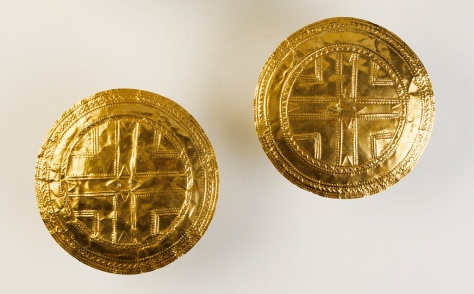
Pair of gold discs, Tedavnet, Co. Monaghan.
Early Bronze Age, 2200 – 2000 bc.
Discovered in the roots of an old tree, this pair of discs is the largest and most sophisticated of the Early Bronze Age discs known from Ireland. A complex arrangement of raised lines, rows of dots and zig-zags has produced a central cross surrounded by concentric patterns similar to other discs but much more elaborate in composition and, technically, far superior. The combination of the techniques of repoussé, punching and polishing, together with the slight doming of the surfaces, highlights and gives a depth and texture to the discs not seen on other pieces.
Lunula

Blessington Lunula; The British Museum
Blessington Lunula, Co WIcklow ; The British Museum
Lunula were worn around the neck. They are cresent shaped and are called after the cresent moon – lunula. They were made by hammering gold flat into a sheet and cutting out the cresent shape using a sharp tool. They were decorated with a technique called “Incision”- this involved cutting or incising into the surface using a sharp tool. Typically the designs that were incised into a Lunula were chevrons (zig- zags) and Lozenges ( diamond shapes). Lunula were among the first gold objects to be made in Ireland and they date to the Early Bronze Age.
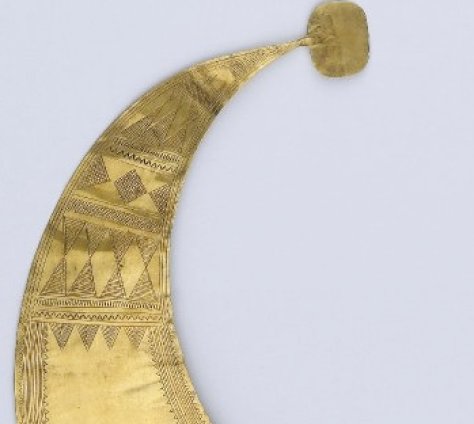
Detail of Gorget. This is a close up view of one of the Terminal Discs. You can see in the very centre there is a large cone shaped Boss. Decorating the surface of the Terminal Disc are rings of raised dots made using the Repoussé technique and also rings of concentric circles which have been engraved into the surface.
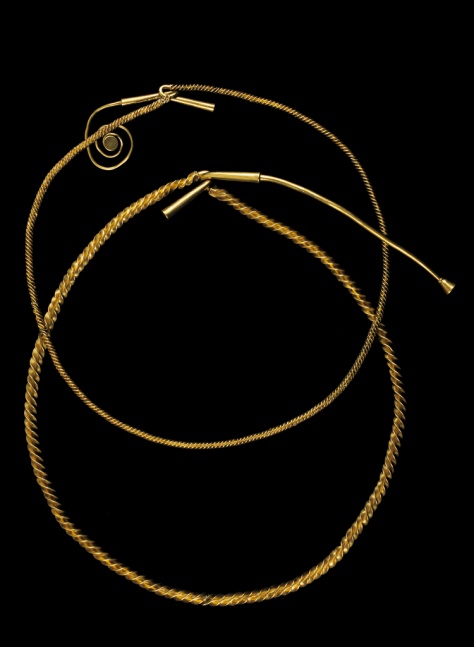
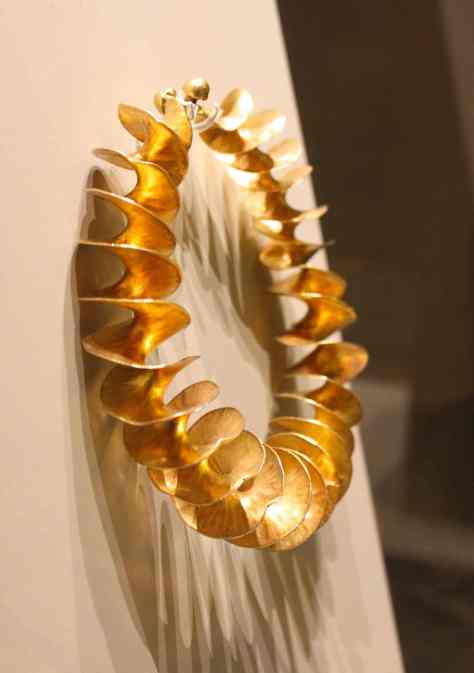

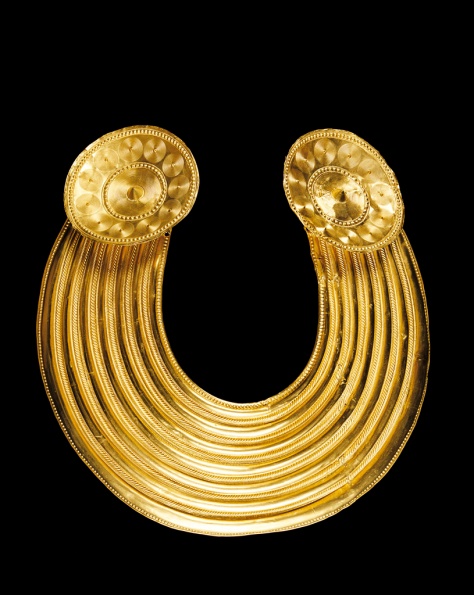
 Detail of Gorget. This is a close up view of one of the Terminal Discs. You can see in the very centre there is a large cone shaped Boss. Decorating the surface of the Terminal Disc are rings of raised dots made using the Repoussé technique and also rings of concentric circles which have been engraved into the surface.
Detail of Gorget. This is a close up view of one of the Terminal Discs. You can see in the very centre there is a large cone shaped Boss. Decorating the surface of the Terminal Disc are rings of raised dots made using the Repoussé technique and also rings of concentric circles which have been engraved into the surface.
The Irish Bronze Age
The Irish Bronze Age dates from approximately 2500 BC
to 500 BC. Archaeologists divide the Bronze Age into
three periods: Early, Middle and Late. These divisions are
founded on the advancement of technological and cultural
developments. The period is characterised mainly by
the beginning of metal-working in Ireland. It is likely the
population of Bronze Age Ireland was highly organised,
with agriculture forming the mainstay of the economy.
Archaeological discoveries from this period predominantly
include burials and hoards of objects
deposited for safe-keeping or as an offering. These
artefacts offer an insight into the complex and ritualistic
aspects of Bronze Age Ireland.
Early Bronze Age
The Bronze Age began in Ireland around 2500 BC. This period saw the introduction of several significant innovations, most notably the development of metal-working. Copper and gold were amongst the earliest metals used. Bronze, an alloy of tin and copper, gradually became a fashionable choice for metalworkers as it was a highly durable metal.
Stone implements, such as flint scrapers, knives, and polished stone axes, still continued in use. Their replacement by metal tools was probably a long and gradual process. Copper and tin were highly prized and costly commodities. Access to these materials was probably confined to elite sections of society. Certain metalwork and pottery was used to display rank and status within Bronze Age communities.
Between the years 2500 BC and 2200 BC, a type
of megalithic tomb known as ‘wedge tomb’ was
used for burial. However, from 2200 BC onwards,
this was replaced by smaller separate burial places.
In varying forms, this was the main burial rite for the
next 1000 years.
The earliest burials were unburnt inhumations,
where a deceased person was placed in a
stone-lined grave called a cist. Offerings were
occasionally placed in the grave alongside the
deceased person. These included artefacts like
vase-shaped or bowl-shaped pottery, which may
have contained food or drink. Older customs
were not entirely abandoned, with passage tombs
and court cairns dating from the Stone Age still
considered sacred sites. These were occasionally
re-used as burial places.
Knowledge of metalworking gradually spread from Europe to Ireland during the 2nd millenium BC ( 2000 years Before Christ).The Bronze Age was called so after the metal Bronze which was a mixture of copper and tin. Copper was a soft metal which was easy to shape and mould and it was discovered that if a small amount of tin was added to copper that a much stronger metal was formed. This new metal was called Bronze. During the Bronze Age this new metal was used to make functional objects such as cooking pots, axes and shields. Gold was the preferred metal to make jewellery and decorative ornaments from. Unlike modern times, gold was commonly found in Ireland during the Bronze Age.
Gold Discs
Gold Discs , also called sun Discs were among the very first metal objects made in Ireland. A piece of gold was hammered flat until it became a thin sheet – like gold foil. Then the circular disc shape was cut out using a sharp tool.
The decoration was made using a technique called Repouss é. This was where the design was hammered in from behind so that it stood up in relief in the front. In the Gold Disc from teldavnet the cruciform design was hammered in from behind. The edges of the disc were decorated with concentric circles which were made using the repoussé technique.
It is believed that these Gold Discs were worn – in the hair or attached to clothes. There are two holes in the centre of the discs ( like a button) where gold wire would have been threaded through to tie the discs to the clothes or the hair.

Gold Disc, Teldavnet, Co Monaghan. In this Gold Disc you can see just how thin the gold has become from being hammered- its like gold foil. You can also see the two holes in the centre which were used to fasten the gold disc using gold wire.

Pair of gold discs, Tedavnet, Co. Monaghan.
Early Bronze Age, 2200 – 2000 bc.
Discovered in the roots of an old tree, this pair of discs is the largest and most sophisticated of the Early Bronze Age discs known from Ireland. A complex arrangement of raised lines, rows of dots and zig-zags has produced a central cross surrounded by concentric patterns similar to other discs but much more elaborate in composition and, technically, far superior. The combination of the techniques of repoussé, punching and polishing, together with the slight doming of the surfaces, highlights and gives a depth and texture to the discs not seen on other pieces.
Lunula

Blessington Lunula; The British Museum
Blessington Lunula, Co WIcklow ; The British Museum
Lunula were worn around the neck. They are cresent shaped and are called after the cresent moon – lunula. They were made by hammering gold flat into a sheet and cutting out the cresent shape using a sharp tool. They were decorated with a technique called “Incision”- this involved cutting or incising into the surface using a sharp tool. Typically the designs that were incised into a Lunula were chevrons (zig- zags) and Lozenges ( diamond shapes). Lunula were among the first gold objects to be made in Ireland and they date to the Early Bronze Age.

Detail of Gorget. This is a close up view of one of the Terminal Discs. You can see in the very centre there is a large cone shaped Boss. Decorating the surface of the Terminal Disc are rings of raised dots made using the Repoussé technique and also rings of concentric circles which have been engraved into the surface.
Torcs
Torcs are twisted bands of gold which were made in various sizes to be worn around the neck, arms,around the waist like a belt or even small ones to be worn as earrings. Torcs date from the middle Bronze Age. They use much more gold than the earlier Bronze Age objects such as the Gold Discs or Lunula and are a much heavier piece of jewellery. . A gold bar or band was twisted to form a rope like pattern. Often the gold bar was beaten thin at the edges to form a flange before being twisted. This is called flange twisting. It produces a much more delicate twisted edge than without flanging.

Two gold torcs, Tara, Co. Meath. Middle Bronze Age, 1200 – 1000 bc. Found at the Rath of the Synods, Tara, Co. Meath, in 1810, these magnificent torcs which, between them, contain over a kilogram of gold, are the finest of their class from Ireland. They are of exceptionally large size and are further elaborated by the addition of extensions to the terminals, a feature which is not recorded elsewhere. Torcs of this type are made from bars of square or rectangular section, the angles of which have been hammered up to produce flanges. The even twisting of such a long bar requires considerable expertise and understanding of the working properties of the metal.

Gold Ribbon Torc . Found near Belfast. 3rd Century BC. National Museum of Ireland. In this Torc you can see that the edges of the gold band were beaten very thin before being twisted. This produces a very delicate appearance like a ribbon giving the name Ribbon Torc
Dress Fasteners
Dress Fasteners of all sizes were made during the middle Bronze Age. This Fastener below is very large and heavy weighing over one kilo. It probably was used only for ceremonial purposes. It is decorated with engraved concentric circles.

Gorget
A Gorget is a type of gold collar to be worn around the neck. Gorgets were made during the Late Bronze Age and they display the range of artistry metalworking techniques that were developed during the Bronze Age. A Gorget is made in three sections. A collar and two Terminal Discs. The collar is decorated with rope pattern designs using the teacnique of Repoussé which involved hammering in the design from behind so that it stood out in relief. The terminal discs show a range of designs and techniques. In the centre a conical shaped boss stands out very prominently from the surface. Covering the surface of each disc is an elaborate design of rings of dots made in Repoussé and rings of incised concentric circles.

Gorget,, Gleninsheen, Co. Clare. Late Bronze Age, 800-700 bc. Found in a rock cleft in 1932 at Gleninsheen, Co. Clare, this collar is an exceptional example of the highly developed goldsmithing skills displayed by Irish craftsmen in the Late Bronze Age. While conforming closely to the pattern of ornamentation prescribed for such collars, the smith, by varying the detail of the motifs, has achieved a tour de force. In particular, the frontal terminal discs are of superb craftsmanship. The layout and execution of the designs incorporating concentric circles, rope patterns and conical and round bosses, have been expertly achieved. Gleeson 1934,



Comments
Post a Comment